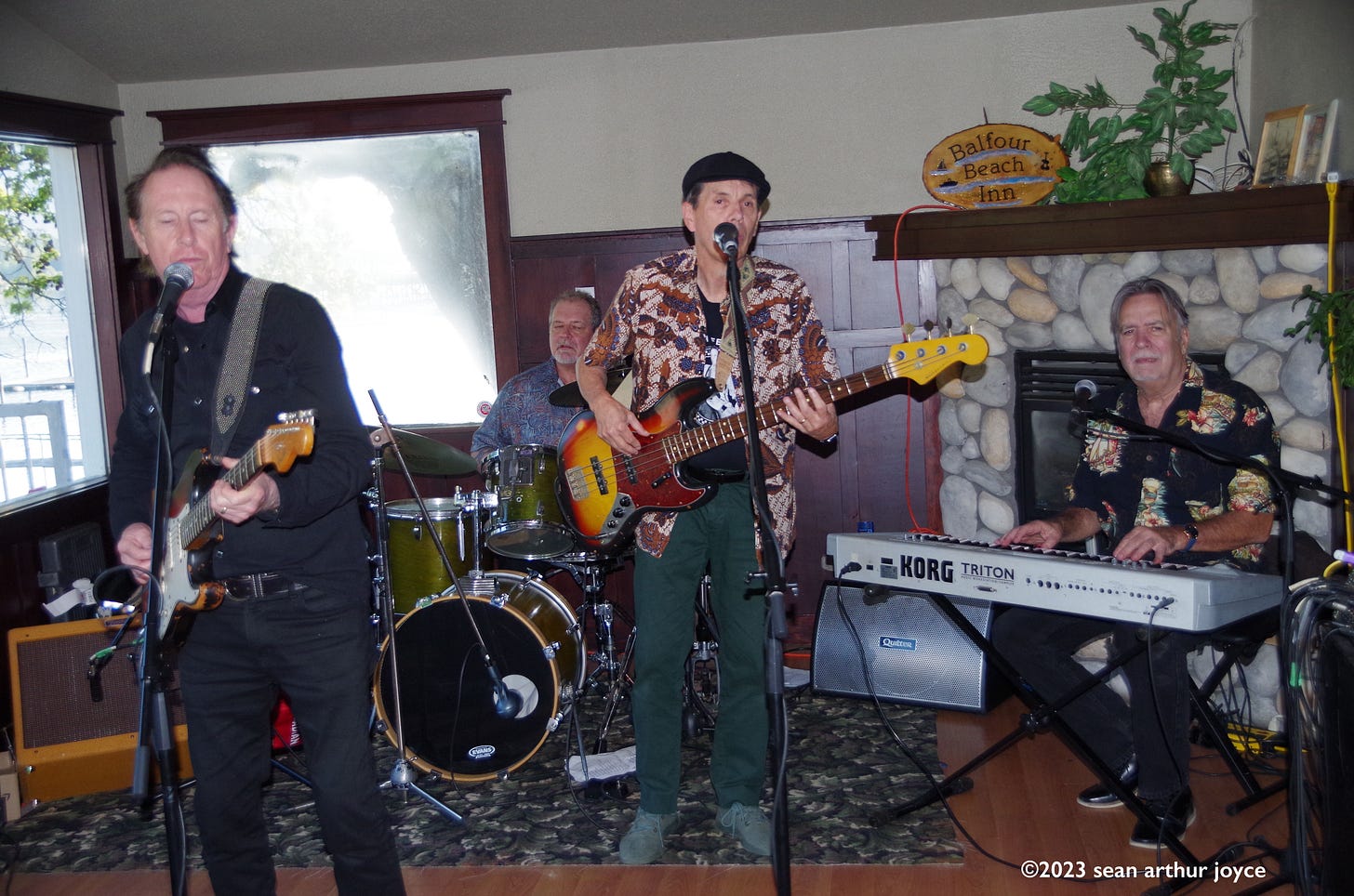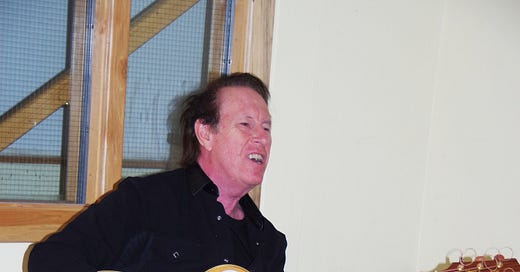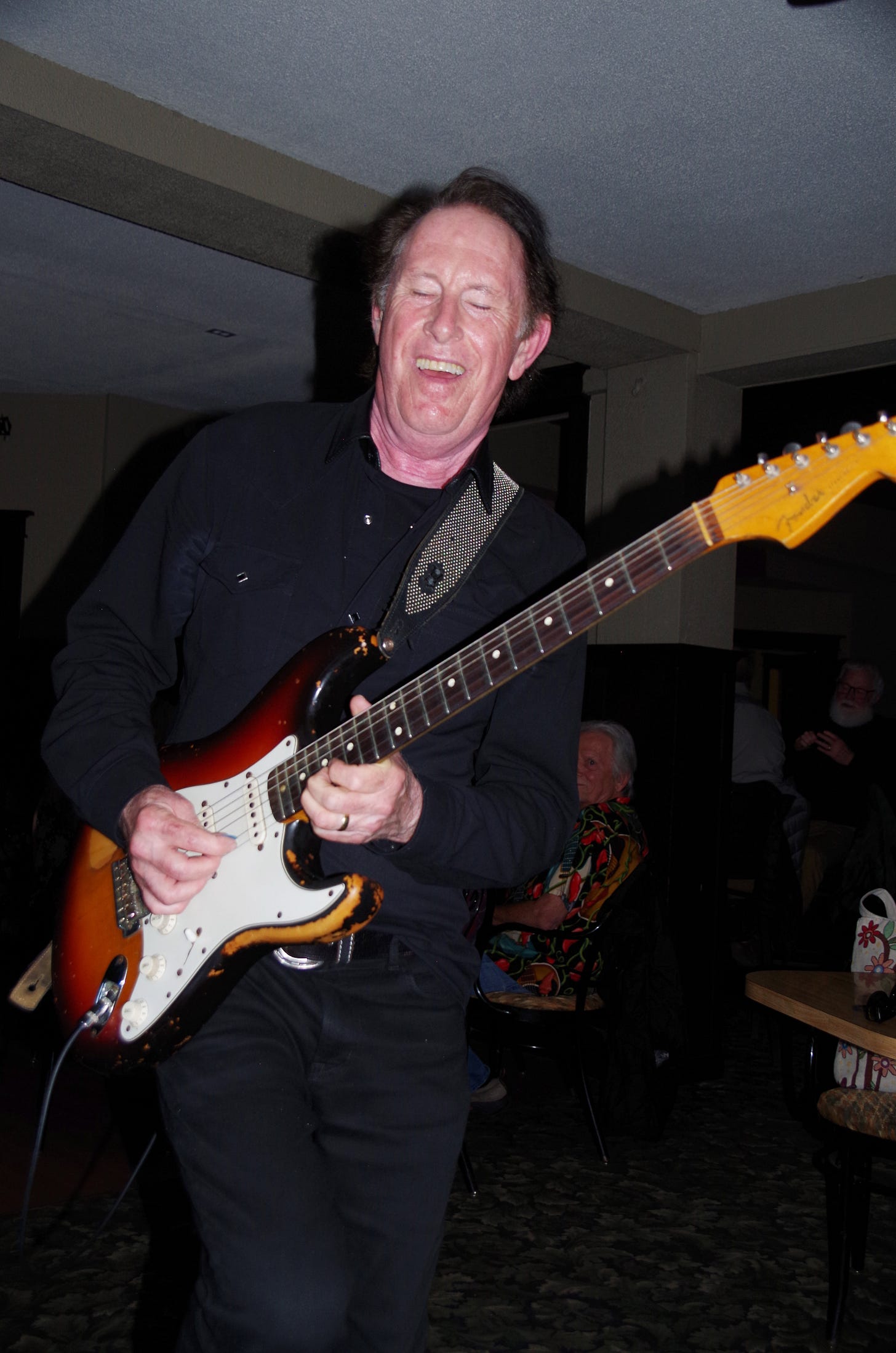Learning at the Feet of a Blues Master
Canadian blues icon Jack de Keyzer on the history of blues guitar
1. A Lesson in the Blues
It’s not every day you get to sit and learn at the feet of a living master. But that’s just what a small, very lucky group of people got to do the afternoon of Friday, May 12 when Canadian blues guitarist Jack de Keyzer gave us a short history of the blues, titled “The Evolution of Blues Guitar.” De Keyzer demonstrated each historical phase of the blues by performing songs on either acoustic or electric guitar, covering from the 1930s to the 1970s. The Kootenay Blues Society hosted the event at the Kootenay Co-op Radio station in a small, unfinished basement room that added to the intimacy of the workshop. We can be thankful that de Keyzer isn’t as famous as Bob Dylan said he’d be if he was born in Chicago or New York. The absence of the star persona means de Keyzer can simply be his approachable, down-to-earth self. This is often the mark of the true master of any art form—a relaxed, joyful mastery of their craft, untainted by ego.
It’s hard to overestimate the influence and persistence of the blues on almost all forms of modern popular music—soul, rock, funk, rockabilly among them. Even within the blues form itself there are endless variations—Delta, Chicago, Texas, swamp blues, to name only four—each with its individual stamp. De Keyzer said there’s also a distinction between city and country blues, especially once Muddy Waters adopted the electric guitar to perform in Chicago clubs. Although Robert Johnson didn’t originate the blues, his fingerprints are all over the blues as we know it today. As de Keyzer explained, his 28 songs have all become blues standards, covered hundreds of times by artists since his death. In the early days when barrelhouse piano was popular, guitarists sought to imitate this rhythm, making it an iconic signature of the blues, for example in songs like Sweet Home Chicago. Lonnie Johnson (no relation to Robert) wanted to imitate the sound of horns on his guitar, resulting in yet another iconic tune, Worried Life Blues.

The 1920s saw a fascination with Hawaiian guitar that gradually morphed into today’s pedal or lap steel and slide guitar sounds. (To hear the evolution of pedal steel guitar, listen to Robert Randolph in any of his stunning Crossroads Guitar Festival appearances over the years.) With the popularity of ragtime piano in the 1930s, once again blues guitarists were eager to incorporate these rhythms to their instrument. It’s about this time that Charlie Christian emerges as a seminal influence for later guitarists. Among his famous protégés would be T. Bone Walker, who became a “granddaddy of electric blues” with his classic Stormy Monday. In the late 1940s a young B.B. King realized he could stake out his own blues territory by speeding up and bending the notes to achieve his signature “singing” tone. De Keyzer performed King’s perennial concert favourite Everyday I Have the Blues.
The American south produced an impressive crop of Delta blues players too numerous to mention here, featuring legendary figures such as Muddy Waters and Howlin’ Wolf. Waters’ stinging slide guitar tone quickly identified his sound once he adopted the electric guitar after moving north to Chicago, as in the Willie Dixon tune Hoochie Coochie Man—a song he played right ’til the end of his career in the 1980s. In the mid-1950s Waters introduced a young man known as Chuck Berry to Chess Records and as they say, the rest is history. “He wanted to play the blues but mostly couldn’t,” said de Keyzer, “so he simplified the bass part to get that iconic Chuck Berry rhythm. He still had what Keith Richards called ‘the roll to his rock.’” (Berry did dip into the blues throughout his career, particularly on albums such as 1967’s Live at Fillmore Auditorium and 1969’s Concerto in B. Goode.)
With the dawn of that golden decade for music, the 1960s, a new blues icon emerged—Buddy Guy, speeding up B.B. King’s licks and adding his own manic twists to them. “Young black musicians during this period thought the old bluesmen were square, so they wanted to do something different,” said de Keyzer. The British Invasion that included the Beatles, Rolling Stones, Animals, et al. changed music forever but their key songwriters and guitarists were devoted blues fans—Eric Burdon, Keith Richards and John Lennon. The mid-60s British blues boom gave black artists’ careers a huge reboot and eager new audiences in England. Championed by Alexis Korner and John Mayall, the movement introduced many of the great guitarists we know today—Eric Clapton, Jeff Beck, and Jimmy Page—again, all influenced deeply by the blues. At a time when segregation still ruled in America and great black bluesmen were still playing in clubs and dives, guitarists like Muddy Waters, Howlin’ Wolf and Chuck Berry could fill the Albert Hall in London. Meanwhile back in the USA, Paul Butterfield, Mike Bloomfield and Al Kooper were the vanguard of popularizing the blues with white audiences.
The Sixties were thus an era of blues innovation, with Clapton in Cream remaking Robert Johnson’s Crossroads with a hard rock edge, the Stones remaking Johnson’s Love in Vain, and of course—Jimi Hendrix! Hendrix had been touring as a backup musician for Wilson Pickett and Ike and Tina Turner but no one could have been prepared for the way he later bent, squeezed and half-tortured his notes. He was probably the first to adopt many of the effects pedals guitarists take for granted today—fuzz, wah-wah, distortion, etc., using his signature Stratocaster guitar as a painter uses the colours on a palette. Even de Keyzer’s body language became more animated when he performed Voodoo Chile for us in that basement room. “To me, Jimi was probably the last great innovator of the blues.”

2. Jack DeKeyzer: A Quick A to Z Biography
De Keyzer’s career took him from rockabilly, something he said he never quite felt comfortable in, through the blues influences heard on his most recent albums Checkmate—with covers of classic Otis Rush, Willie Dixon, Elmore James, and Howlin’ Wolf—and Tribute, an album of all-original songs that brilliantly recaptures the spirit of these original masters, including a very Cream-like closer in Forever. De Keyzer, like many great musicians, started early, playing his first cheap guitar at age 8 while his family was living in England. After moving to Canada he got his first electric guitar, a Saturn with a Silvertone amplifier, ordered from the Sears catalogue. He cites 1964 as a pivotal year of musical influences on his childhood, hearing James Brown, Sam and Dave, the early Rolling Stones and the Stax Records artists. De Keyzer taught himself to play Hendrix’s entire first album, Are You Experienced? but fell equally in love with Jimmy Reed and Otis Rush. He cites Toronto-based King Biscuit Boy as his favourite Canadian bluesman and says Danny Gatton was another important influence. De Keyzer joined Ronnie Hawkins’ legendary band in 1973. His fascination with Gene Vincent led to a rockabilly stint with The Bobcats from 1979–85 before forming his own band to explore blues forms more widely. There was a brief attempt by a record company to market de Keyzer as a country artist, “but that wasn’t really me.” A career highlight was playing guitar for Etta James, herself a devotee of Johnny Guitar Watson—“you can hear it in her vocal style.” James told de Keyzer, “You’re like a Canadian Keith Richards,” high praise indeed. He also met the late Master of the Telecaster Roy Buchanan.

With such a wide-ranging palette of blues influences, it’s no wonder de Keyzer’s concerts at Finley’s Bar & Grill and the Balfour Beach Inn were such a soulful, blistering stroll through the history of the blues. (The two venues are the main hosts for Kootenay Blues Society concerts.) The man is capable of playing any style with equal finesse and feeling—quite likely Canada’s top living blues guitarist. His band was lockstep tight, with Chip Hart on drums, Roger Brant on bass, and Mike Kalanj tickling the electronic ivories on a Korg keyboard. A highlight of the BBI concert was seeing de Keyzer wade onto the dance floor mid-solo with his battered Stratocaster, grinning with the sheer joy of the moment.
Best of all, he carries no superstar airs and graces, making him a heck of a nice guy to talk to. What could be more Canadian than that?
To read my reviews of Jack de Keyzer albums visit:
“Catching Up on the Canuck Blues” review of The Best of Jack de Keyzer:
https://chameleonfire1.wordpress.com/2018/02/27/catching-up-on-the-canuck-blues/
“Good Time Blues for Bad Time Days” review of Tribute:
https://chameleonfire1.wordpress.com/2021/03/31/good-time-blues-for-bad-time-days/




I can't comment on your knowledge of Blues but I can say that I fondly remember Sweet Home Chicago in The Blues Brothers, and Black Betty by Leadbelly!